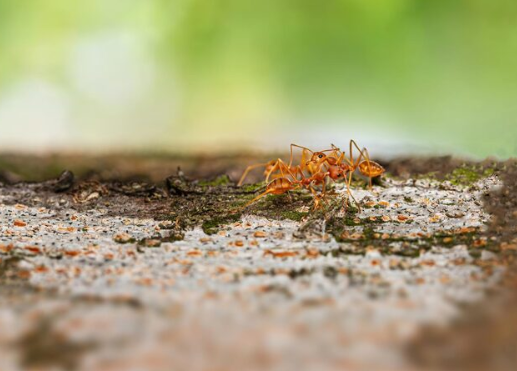When a single scout is spotted in your pantry, it is a silent alarm signaling the urgent need for effective ants pest control.
These serious insects are more than just a problem in your home; they are a formidable force capable of contaminating food surfaces, causing surprising structural damage as they nest in walls and foundations, and even posing electrical hazards by chewing through wiring.
Their relentless trails are a testament to their sophisticated survival skills, which make over-the-counter sprays and DIY remedies little more than a temporary, frustrating setback for them.
True eradication requires a strategic approach that goes beyond killing. To reclaim your space and ensure these uninvited guests are shown the door for good, understanding of the threat is the first critical step toward a permanent solution, one that targets the heart of the infestation: the queen and her nest.
It Starts with One… Until Your Home Becomes Theirs
The discovery of a lone ant meandering across your pristine kitchen countertop is a moment many homeowners dismiss. It’s just one ant, after all.
What harm could it possibly do?
This line of thinking is the most common and costly mistake one can make. That solitary insect is rarely a lost wanderer; it’s a highly-trained scout trained from a nearby colony, tasked with a critical mission: to locate food and water sources for thousands of them.
When it finds a crumb or a sticky spill on your counter, it doesn’t simply feast and leave. It returns to the nest, laying down a precise chemical trail that directs the entire army of foragers straight to the jackpot it discovered.
The lone ant you saw one day becomes a relentless, unwavering trail the next, and a full-blown infestation soon after.
This rapid escalation from minor nuisance to major problem is the first and most alarming sign that you are not dealing with a simple issue, but a sophisticated biological operation.
The Hidden Dangers of an Infestation
Many people assume ants are merely unpleasant to look at, but the risks they introduce into your home are far more significant.
The primary concern is food contamination and the spread of pathogens.
Ants traverse a wide range of environments, from clean countertops to filthy garbage bins, decaying wood, and even animal carcasses.
In the process, their six-legged bodies pick up bacteria like Salmonella, which they then track directly onto your food preparation surfaces and pantry items.
Furthermore, certain species pose direct threats to your property. Carpenter ants, often confused with their harmless counterparts, are a significant structural pest. They do not eat wood but excavate it to create vast, intricate nesting galleries.
Over time, this can compromise the structural integrity of wooden beams, window frames, and other vital components of your home, leading to costly repairs.
The Vicious Cycle of DIY Failure
Faced with a trail of ants, the instinctive reaction for many is to reach for a can of store-bought insecticide spray or to lay down bait traps from the local supermarket.
While these methods might provide a momentary sense of victory as you watch ants die, they are almost universally a short-term fix that can inadvertently worsen the problem. Sprays, in particular, are counterproductive.
They kill the visible foragers but leave the hidden nest completely untouched.
Worse, the repellent chemicals can splinter the pheromone trail, causing the colony to simply divert its workers to a new, less obvious entry point or, in a survival response, to split into multiple colonies (a process known as budding).
Store-bought baits, while a better concept, often fail because they use generic attractants. Different ant species have different dietary preferences; some crave proteins, while others seek sugars, and using the wrong bait means the workers will simply ignore it.
This cycle of killing a few visible ants while the queen, safely hidden away, continues to lay thousands of eggs ensures the infestation will return, often with greater force and resilience.
How Delay Turns a Problem into a Crisis
That initial trail of ants is more than an annoyance; it is a ticking clock.
Every day you wait, hoping they will disappear on their own or relying on ineffective solutions, the colony grows stronger and more entrenched.
What begins as a foraging party can quickly evolve into a satellite colony establishing itself within the very structure of your home. Walls, subfloors, and insulation provide ideal, protected nesting sites.
As the population booms, the scouts redouble their efforts, creating new trails and discovering new food sources throughout your house. The problem soon moves beyond the kitchen, appearing in bathrooms, bedrooms, and living areas, making your entire home feel contaminated.
This delay often leads homeowners into a frustrating cycle of DIY failure. Each unsuccessful spray or ignored bait trap doesn’t just waste time and money; it deepens the infestation.
The ants become wiser, avoiding your traps and becoming harder to kill. Meanwhile, the core of the problem remains untouched. A carpenter ant colony, left unchecked, will relentlessly excavate the wooden framework of your house, compromising its structural integrity over time, leading to repairs that cost thousands.
Furthermore, the pheromone trails and food sources left by an ant infestation can act as a dinner bell for other pests, potentially attracting secondary invasions.
What started as a simple ant problem has now escalated into a full-blown property crisis.
The Path to a Lasting Ant-Free Home
The frustration of a recurring ant invasion has a definitive and effective conclusion: professional intervention.
While DIY methods attack the symptoms, a targeted pest control strategy eliminates the source.
Expert exterminators don’t just kill the ants you see; they perform a thorough inspection to identify the specific species, locate their nesting sites, whether in the soil outside or deep within your walls, and understand their foraging behavior.
This intelligence is critical.
Based on their findings, they implement a multi-pronged solution, often using advanced baits that worker ants carry back to the heart of the colony, effectively poisoning the queen and the brood.
This breaks the reproductive cycle and ensures the entire population collapses from the inside out.
This professional treatment is complemented by crucial exclusion and sanitation work. Sealing cracks in foundations, around windows, and utility entry points denies ants easy access.
Consistent cleaning to remove food residues, combined with proper food storage, removes the attractants that drew them in the first place.
The final step is a proactive defense.
Many professional services offer ongoing monitoring and preventative treatments, creating a protective barrier around your home.
The Professional Path to an Ant-Free Future
Don’t let a small problem become a monumental headache.
You’ve seen how a single ant can escalate into a costly invasion and how DIY solutions fall short. You deserve a home that is truly your own, a safe, clean, and protected sanctuary. Stop battling the endless trails and start targeting the source.
Ready to reclaim your peace of mind? Contact a professional ant control expert today.








